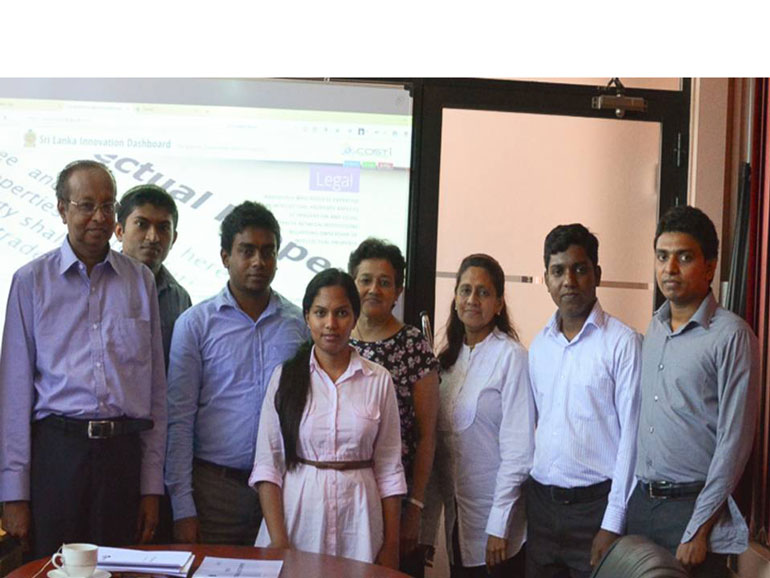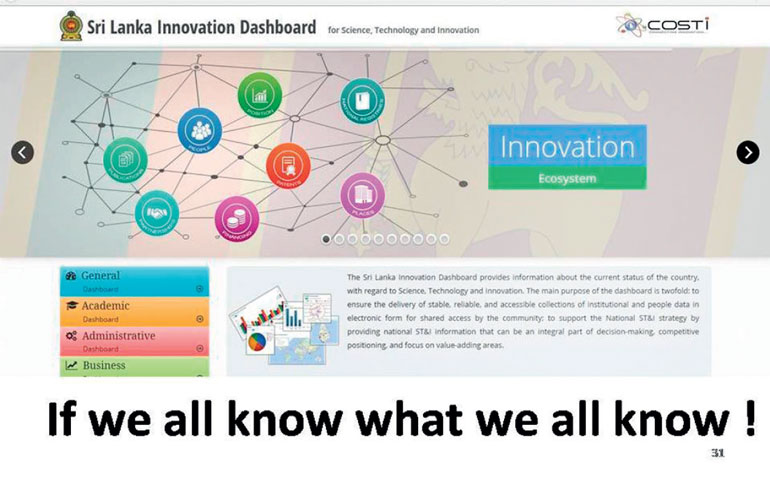Sunday Dec 07, 2025
Sunday Dec 07, 2025
Thursday, 22 October 2015 00:00 - - {{hitsCtrl.values.hits}}
 The LSF team with members of the IT team of COSTI
The LSF team with members of the IT team of COSTI
What you cannot measure you cannot manage is an old adage. However, this can be questioned many a time in Sri Lanka as managing minus data appears to be the norm. When data are available the discussion is also different. Then we keep on questioning data than accepting them.
It is also interesting to note how many projects do start with the activity of creating databases only to find that at the end of the project the database too ends up again to be resurrected with the same beginning by another project. The nation being developed as a collection of projects is not a way to move on as the number of projects that we have had in almost all the sectors up to now surely amounts to an astronomical number. The funny aspect is that we want to plan more projects.
Dashboard is an interesting concept. The origin of the word however, refers to a plank or leather fixed in front of the horse driven carriage that prevented mud from being splattered on the driver and the carriage from the movement of horses.
However as we move on from horse driven to automobiles dashboards have taken a whole new meaning – it refers to the panel placed in front of the driver housing instrumentation and other controls. Thinking beyond the usual automobile, train or even an airplane, sitting in front of a screen with all what you want to know to be on top of a situation, getting flashed in real time is a dream scenario. In this day and age when power at your fingertips is an aspiration dashboards tuned to a particular environment appear to be an excellent tool in enabling that feeling of knowing all and being in charge.
If I am to have a dashboard on trade the indicators are sure to haunt me. Month on month the figures are quite disturbing. While we get millions for what we sending out, we have to spend billions to get what we want. It is a haemorrhage in dollars and the issue has been addressed via allowing the humble rupee to float and expecting the devaluation to buck the trend.
The most feasible and the sustainable way of addressing the problem lies in changing the economy and really fast tracking it to an innovation economy. Easier said than done but one has to start somewhere. Now this economic transformation and understanding the ‘troop movements and their battles’ would mean answering the question can we have a dashboard on innovation covering the Sri Lankan space primarily and with all the networking added on.
Sri Lanka Innovation Dashboard
The Sri Lanka Innovation Dashboard was an activity that was conceptualised and developed by COSTI (Coordinating Secretariat for Science Technology and Innovation). At the inception of COSTI the team wanted to map the innovation space and starting with the researcher information was vital.
While multiple organisations do carry surveys over the same area there is no sharing of information and at times when the report finally emerges after using the data the report is quite out of date. Why multiple organisations carry on surveys, why don’t the resultant information are not shared, and in this day and age why we want to send bundles of paper based questionnaires to personnel are questions that eludes a sensible answer.
An innovation eco system
An innovation eco system will have a great number of actors working collaboratively. In Sri Lanka this eco-system had been slow to develop. We have many an institution working alone or working as per instructions of one line ministry. COSTI had mapped around 67 research institutes, universities, etc. falling under 22 line ministries. All these potentially host idea generators and idea converters.
These institutions however lack the wherewithal to commercialise and they also are trapped within historical procedures which effectively curtail execution. Through networking and with some alignment some of the limitations could be eliminated and this is how the eco system for innovation should be developed.
The Sri Lanka Innovation Dashboard as the very first step present this entire institutional setups with their members and bring out all what they are doing and have done – papers, patents, products, partnerships (both external and internal), etc.
With the initial introduction of the individuals COSTI expects all to join into the Dashboard and maintain their homepage. The result of all contributing in this manner is to elevate the respective institution via its report card. All other actions too are expected to be captured – research registry identifies all projects that are currently happening and this information can even help in recruitment and project planning.
If one can align 10,000 university projects to national objectives – either for public or private enterprise – which at present has near zero alignment the result immediately would be a big difference. Dashboard recognises any inventor big or small!
Information from the National Intellectual Property Office and the Inventors Commission too are connected as inventors and patents are important elements of a nation’s intangible asset base. This too is an area Sri Lanka should start to think differently – How should we leverage our intangible assets to contribute to GDP? Dashboard provide data to plan. Broadly the dashboard also captures the Global Innovation Index rankings and related indicators and points to areas for improvement.
The system was developed by Lanka Software Foundation, a non-profit organisation formed with the objective of promoting open source development, with the close collaboration of the IT team of COSTI. The information is classified according to the OECD Classification System and supports robust search of data.
It is interesting to note the work in Phase 1 was completed within a year and principally by three young IT graduates from Universities of Sri Jayewardenepura, Colombo and SLIIT. A point to note is the procurement to initiate the dashboard development took one year! This is distressing.
Even though COSTI is for innovation, procedures through which one has to deliver are in our view archaic. Unless these shortcomings are understood and corrected, expectations are likely to remain as distant dreams. We cannot deliver the future we espouse by trapping ourselves to the past.
Interesting lessons
The story behind the delivery of Sri Lanka Innovation Dashboard has some interesting lessons to be shared primarily to indicate what should be speedily dismantled in our system for improving efficiency and effectiveness. Again the young team demonstrated how much can be achieved with proper support and the possible impact.
It is heartening that UNDP Sri Lanka has primarily agree to partner in the next phase of Sri Lanka Innovation Dashboard development. This should position this development firmly within the planning sphere. Today road shows are on with COSTI team visiting institutions including private sector organisations and wooing them to the site.
The ‘welcome’ to the site as a member is not only for academics, researchers and inventors. Venture capitalists, fund managers and financiers too can join in as they too provide a vital link in the innovation value chain. Funders too will also find the dashboard an excellent reference point once a significant data bank had been developed. The information contain within can provide feedback on questions of allocation of funds for any proposed project. BOI too could use the information in driving in FDI as information on specialised human resource data being available.
Dashboard is a web application. Anyone can use the dashboard application, but only registered users are able to save data to the database. All approved registered users are effectively innovation actors of Sri Lanka. The Sri Lanka Innovation Dashboard can be accessed through https://dashboard.costi.gov.lk. Or through the COSTI web site (www.costi.gov.lk).
Join in and populate this national portal
Currently the call is on to join in and populate this national portal. It is hoped with time the community out there will join in and add data. If I am to quote COSTI’s IT Director Dr. Geetha Abeysinghe, “Some are reluctant to share data, even the academics. Although most academics publish their profiles in global portals, in order to put their profiles on a national portal some seek a superior’s permission. But this is a national portal and everyone should understand that it is for a national cause, see the value of publishing their profiles and should take the lead to share and maintain the currency of their information.”
We need to shed this negative attitude towards local products and services. I do acknowledge my serious negative attitude on local procedures though. The development was done with minimal strain to the national coffers. As LSF was a not for profit organisation this was made possible. The dashboard is a testimony to the fact that a lower cost does not necessarily mean lower quality. A dashboard for the nation has been developed. Over to you national planners…

Home page of the Sri Lanka Innovation Dashboard

The SL-IDB calling card – Please do join in